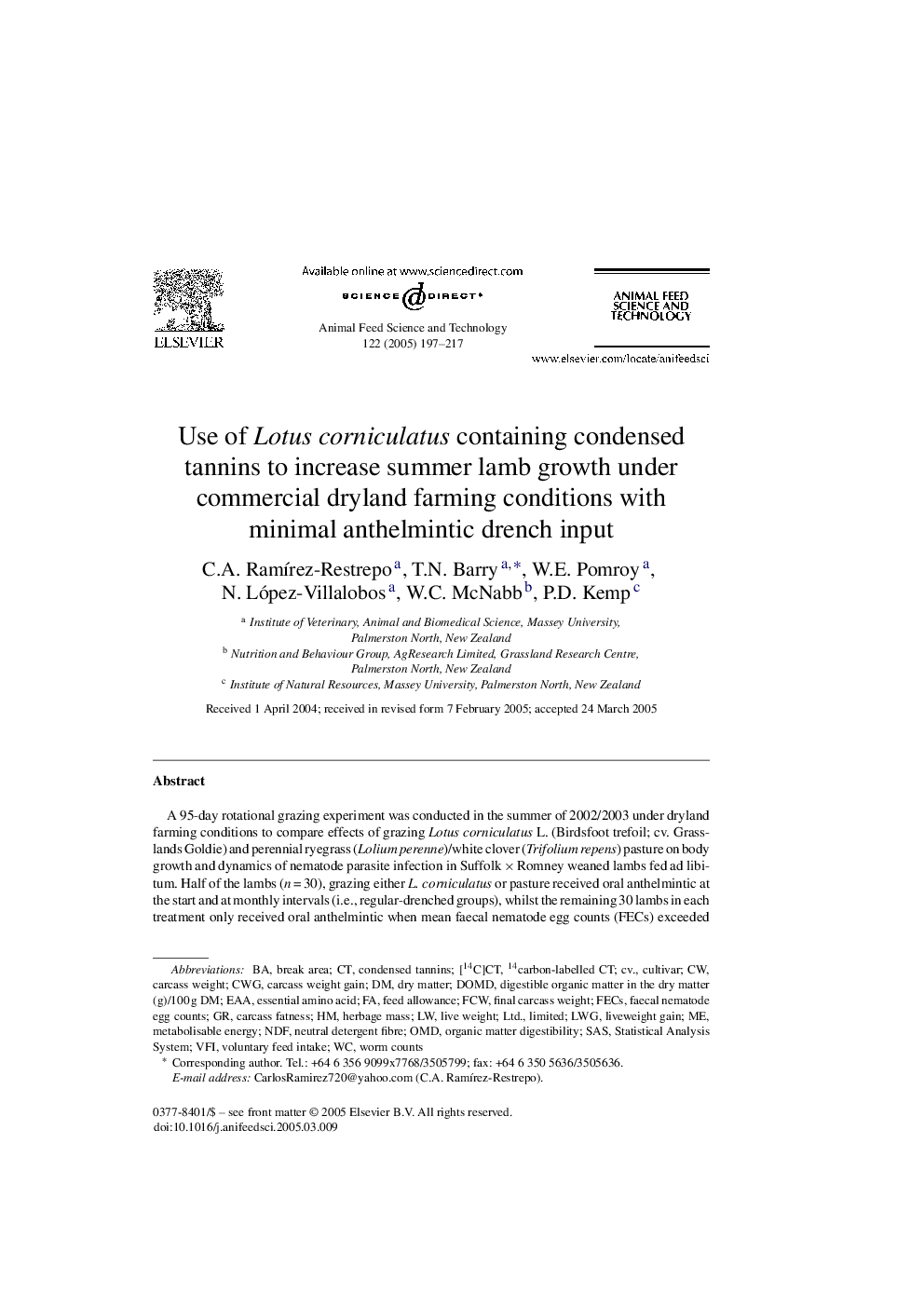| Article ID | Journal | Published Year | Pages | File Type |
|---|---|---|---|---|
| 8973658 | Animal Feed Science and Technology | 2005 | 21 Pages |
Abstract
A 95-day rotational grazing experiment was conducted in the summer of 2002/2003 under dryland farming conditions to compare effects of grazing Lotus corniculatus L. (Birdsfoot trefoil; cv. Grasslands Goldie) and perennial ryegrass (Lolium perenne)/white clover (Trifolium repens) pasture on body growth and dynamics of nematode parasite infection in Suffolk Ã Romney weaned lambs fed ad libitum. Half of the lambs (n = 30), grazing either L. corniculatus or pasture received oral anthelmintic at the start and at monthly intervals (i.e., regular-drenched groups), whilst the remaining 30 lambs in each treatment only received oral anthelmintic when mean faecal nematode egg counts (FECs) exceeded 1000 eggs/g wet faeces (i.e., trigger-drenched groups). This only occurred on day 58 for both groups. Trigger and regular-drenched lambs grazed separate areas. Total condensed tannin (CT) concentration in the diet selected was 31-40 g CT/kg DM for L. corniculatus, with only trace amounts in pasture. In vitro organic matter (OM) digestibility (OMD), digestible OM in dry matter (DOMD), and metabolisable energy (ME) concentration were higher for L. corniculatus versus pasture and declined less under drought conditions versus grass-based pasture. Regular-drenched lambs grazing L. corniculatus had higher liveweight gain (LWG; 298 g/day) and carcass weight gain (133 g/day) than all other groups, whilst trigger-drenched lambs grazing L. corniculatus had higher LWG (228 g/day) and carcass gain (99 g/day) versus regular-drenched (200; 66 g/day) and trigger-drenched (187; 63 g/day) lambs grazing pasture. Carcass fatness was lower for trigger-drenched lambs versus regular-drenched lambs, when fed either L. corniculatus or pasture. Dag score was consistently lower for regular-drenched lambs grazing L. corniculatus versus pasture; trigger-drenched lambs showed similar effects up to day 48, with no differences between the groups thereafter. Regular anthelmintic treatment maintained FECs at low values, while parasitised grazed lambs on L. corniculatus tended to have higher FECs than pasture fed lambs. Relative to trigger-drenched lambs that grazed pasture, grazing L. corniculatus reduced worm burdens at slaughter of Haemochus contortus, Teladosargia spp., Nematodirus spp. and Cooperia spp., but higher burdens of Trichostrongylus spp., Chabertia ovina, Oesophagostonum spp. and Trichuris ovis ocurred in L. corniculatus fed lambs. Grazing Lotus corniculatus L. (Birdsfoot trefoil; cv. Grasslands Goldie) under dryland farming conditions can increase growth of weaned lambs, whilst reducing reliance on anthelmintic drenches to control parasites. These effects are possibly due to increased metabolisable protein supply, from the protein binding action of CT, enabling the lambs to grow faster when carrying a parasite burden, and to L. corniculatus better maintaining its high ME value under drought conditions. Mechanisms for the action of CT are discussed.
Keywords
NDFDryland farming systemsDOMDLWGCWGOMDFaecal nematode egg countsCarcass fatnessWorm countsVFIEAAFCWSASEssential amino acidLiveweight gainmetabolisable energyCondensed tanninsHerbage masscv.CultivarStatistical Analysis Systemneutral detergent fibreLotus corniculatusdry matterLimitedVoluntary feed intakeOrganic matter digestibilityLive weightCarcass weight
Related Topics
Life Sciences
Agricultural and Biological Sciences
Animal Science and Zoology
Authors
C.A. RamÃrez-Restrepo, T.N. Barry, W.E. Pomroy, N. López-Villalobos, W.C. McNabb, P.D. Kemp,
